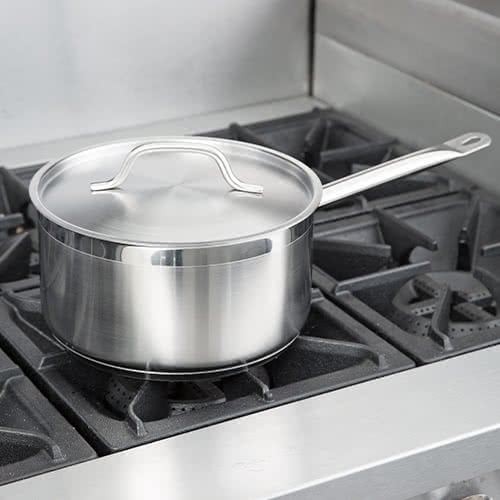Pots vs Pans
Matching the proper cookware with the right cooking method is tricky when there are so many types of pots and pans to choose from. Each type of cookware has unique benefits that can improve your dishes when used correctly. We'll explain the differences between pots and pans and identify 5 of the most popular styles so you can choose the right pan for the job.
Shop All CookwareWhat Is the Difference Between a Pot and a Pan?
A pot has tall sides and two loop handles, while a pan is shallow with one long handle. Pots are used for simmering or boiling liquids that completely cover ingredients to cook from all sides. Pans are used for cooking methods that apply high heat to produce browning, like reducing, sauteing, searing, or frying.
We'll introduce 5 different pots and pans below: saucepans, sauciers, saute pans, sauce pots, and stock pots. Even though these names sound very similar, each piece of cookware has a different use. An easy way to remember the difference between them is to imagine you're preparing a traditional lasagna with boiled noodles and a creamy bechamel sauce:
- Slow cook a flavorful tomato sauce in a saucepot
- Brown meat for the sauce in a saute pan
- Whisk a creamy bechamel sauce in a saucepan or saucier
- Boil the lasagna noodles in a stock pot
1. Saucepan

Saucepans are one of the most versatile types of cookware in a commercial kitchen. They're lightweight with one long handle and are easy to grab when you need to whip up a sauce or gravy. They have tall sides and narrow bases that heat liquid ingredients from all sides to promote reduction, the action that adds thickness and intense flavor. For this reason, saucepans are the best choice for making different types of sauces.
They can also be used for simmering and boiling liquids to cook smaller portions of rice, pasta, or vegetables. For larger quantities of pasta or rice, look for a saucepan with a helper handle so it's easier to pour out the liquid into a strainer.
- Saucepan Uses - Reducing sauces, blanching vegetables, boiling liquid for soups, pasta, rice, or beans
- Saucepan Characteristics - Low to medium volume, tall sides, narrow base, single long handle, usually includes a lid
- Pot or pan - Both; can be used as a pan for thickening sauces or a pot for simmering liquids
Saucepan vs Pot
Saucepans tend to cause confusion because they have high sides like a pot, but they also have one handle like a pan. So is a saucepan considered a pot or a pan? The answer is that a saucepan can be both, even though its best application is when used as a pan for reducing sauces.
2. Saucier Pan

Saucier pans (pronounced soh-see-ay) have curved walls and a rounded base that allows for an uninterrupted motion while stirring, whisking, or tossing. This gives the chef more control over how evenly food cooks and prevents ingredients from getting stuck in the corners.
Sauciers are ideal for reducing sauces or cooking delicate custards that need constant stirring so they don't burn. Reach for the saucier if your sauce contains eggs, milk, or cream. You can also use a saucier as a stir-fry pan.
- Saucier Uses - Reducing creamy sauces, preparing custards or pastry creams, stir frying
- Saucier Characteristics - Low to medium volume, curved sides, rounded base, single long handle
- Pot or pan - Pan; the base and walls of the saucier use high heat to thicken sauces
Saucier Pan vs Saucepan
A saucier pan is similar to a saucepan, except it has curved walls instead of straight sides. Sauciers also have a wider diameter base and lower sides compared to a saucepan, which encourages quicker evaporation. Use a saucier for creamy sauces that need constant stirring and stick to a saucepan with taller sides for sauces that might bubble and splatter.
3. Saute Pan

Saute pans have low straight walls and a wide base that provides a large cooking surface. The shape of the saute pan is useful because it provides a couple extra inches of surface area when compared to skillets of the same size. More ingredients fit inside the pan to prevent overcrowding, and the walls keep liquids from splashing out.
- Saute Pan Uses - Searing meats, braising, pan frying, sauteing
- Saute Pan Characteristics - Low to medium volume, straight sides, large diameter base, single long handle
- Pot or pan - Pan; the large cooking surface of a saute pan uses high heat to cause browning
Saute Pan vs Skillet
Saute pans and skillets are both used for sauteing and frying, but they have a key difference. The straight walls of a saute pan are higher than the curved flare of a skillet, keeping hot liquids from splashing. This makes saute pans better suited for shallow frying or braising.
4. Sauce Pot

Sauce pots have high walls, a large diameter base, and two loop handles. Like a saucepan, the shape is designed for quick evaporation and reduction of sauces. However, sauce pots have a much higher volume, so the process of evaporation takes place more slowly and requires less stirring. This makes sauce pots ideal for sauces and stews that benefit from slow cooking.
- Sauce Pot Uses - Slow cooking sauces, stews, and soups
- Sauce Pot Characteristics - Medium to high volume, tall straight sides, large diameter base, two loop handles
- Pot or pan - Pot; the high volume of a sauce pot covers ingredients in liquid to cook from all sides, but the shape encourages reduction
Sauce Pot vs Saucepan
The difference between a sauce pot and a saucepan comes down to volume. Sauce pots have tall sides and a large base for cooking larger quantities of sauces. Reach for the saucepot if you need to slow cook a sauce, and choose a saucepan if you need to make a quick sauce that requires constant whisking and attention.
5. Stock Pot

Stock pots are easy to identify because they are usually the largest pot in the kitchen. They have the highest walls with a base that's small in comparison to the height of the pot. The shape of the pot allows large quantities of liquids to heat up without evaporating, which is ideal for cooking stocks and soups.
- Stock Pot Uses - Simmering and boiling liquids for stocks, soups, and pasta
- Stock Pot Characteristics - Medium to high volume, tall straight sides, small diameter base, two loop handles
- Pot or pan - Pot; stock pots are ideal for simmering or boiling ingredients without any reduction
Stock Pot vs Sauce Pot
Stock pots and sauce pots look alike because they are both large pots with two loop handles. To tell them apart, just remember that a stock pot has higher walls and a narrower base than a sauce pot. The difference in shape makes stock pots better suited for moist heat cooking applications that don't require thickening or reducing, like boiling, simmering, and steaming. Sauce pots are designed for reducing liquid to make thicker sauces or stews.
If you've been using a pot for reducing sauces and a pan for simmering soups, now you know there's an easier way! Use a saucier pan for thickening sauces and save the stock pot for boiling liquids. Consider investing in a good saucepan because they are versatile enough to be considered both a pot and pan. Check out our saucepan buying guide to learn more about the different sizes and materials available.








